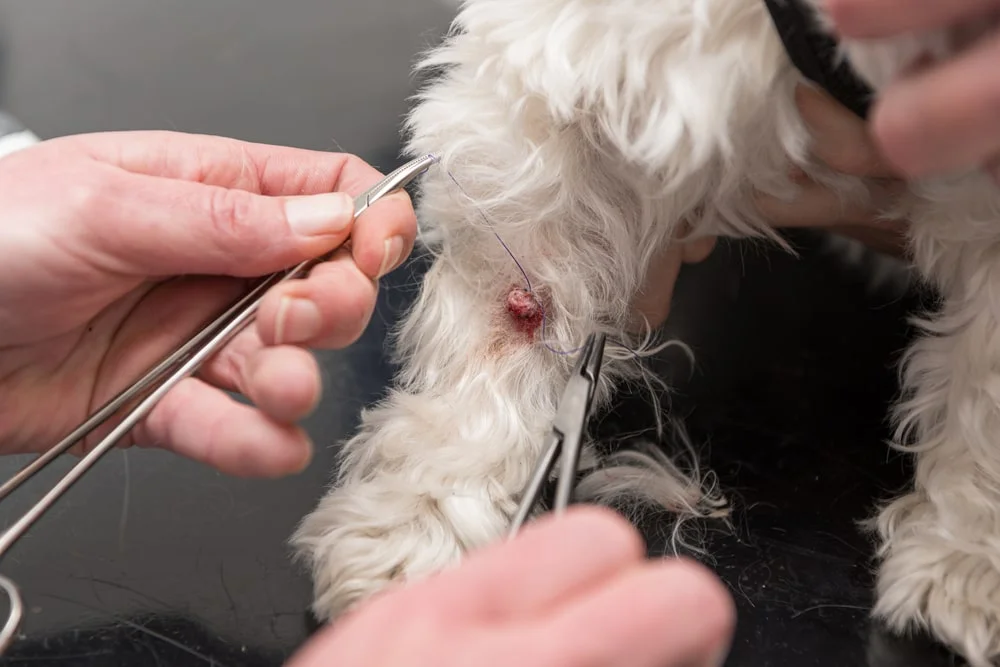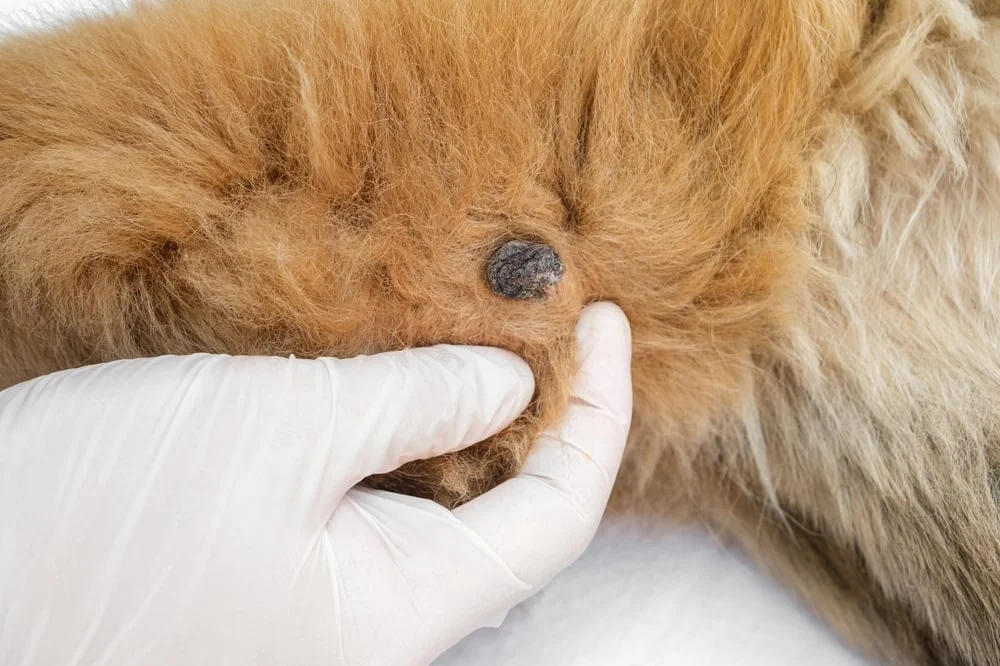PET HEALTH
Despite their fur-covered bodies, dogs are susceptible to a variety of skin conditions and irritations. Beneath that furry coat, your dog’s skin might display a variety of lumps and bumps, bruises, moles, and warts.
Pet parents may be surprised to find warts on their dogs. But these skin abnormalities are more common in dogs than you might think.
The good news is that warts on dogs can generally be harmless and may even resolve on their own. However, understanding what causes dog warts and knowing when to seek veterinary treatment can provide pet parents much-needed peace of mind.
So let’s delve into the world of dog warts for some helpful guidance from veterinary experts!
What Are Dog Warts?
“Dog warts are benign growths caused by a canine papillomavirus (CPV),” explains Dr. Hanie Elfenbein, DVM, emergency clinician at the Animal Emergency & Specialty Center in Chattanooga, Tennessee. “There are two main strains of this virus: CPV-1 and CPV-2,” she adds. “CPV-1 tends to cause warts on the face, while CPV-2 warts tend to occur on the belly and feet.”
Dr. Sylvalyn Hammond, DVM, a general practice and emergency relief veterinarian based in Mount Pleasant, South Carolina, points out that dog warts have a distinct, cauliflower-like appearance and are more commonly found in younger dogs.
This is likely due to younger dogs’ immature immune systems, Hammond says. Because warts are caused by a virus, dogs with a weakened or immature immune response are more susceptible to developing them.1
If you discover a wart on your dog, there's no need to panic. According to Dr. Hammond, warts on dogs typically aren’t malignant and usually disappear on their own within 3 months.
Can People Get Warts From Dogs?
Dr. Hammond emphasizes that while both humans and dogs can get warts, dog warts aren’t contagious to humans. “A lot of my patients’ humans are concerned about transmission. But it’s not possible for a human to catch warts from a dog.”
What Causes Warts on Dogs?
While it's comforting to know that dog warts won't spread to humans, other dogs aren’t as fortunate. Since dog warts are caused by a virus, they can be highly contagious between dogs — especially those who regularly visit locations that vets consider high risk for papillomavirus transmission.
“This virus is easily spread by dogs sharing toys and bowls,” says Dr. Elfenbein. “Dogs who attend day care or go to dog parks are most likely to contract the virus and develop warts.”
Here, age also plays a role, says Dr. Hammond. “Think about how younger dogs behave at a dog park. They're more rambunctious when they play and may claw at or nibble on each other,” she notes.
“That’s part of the reason why warts are so often found around the mouth and on limbs — that’s where scratches occur,” Dr. Hammond says. “Even the narrowest scrape can let that papillomavirus get into the skin.”
What Do Warts Look Like on Dogs?
Some of the most common types of dog warts can be those caused by the CPV-1 strain. These growths tend to have a distinctive, cauliflower-like appearance, with a rough, pebbly surface texture. They’re typically pink or gray in color and are usually longer — or more protrusive — than they are wide.
Dog warts caused by CPV-1 typically occur in clusters. They’re also known as canine oral papillomas, as they tend to be warts on a dog’s mouth — developing in moist mucous membranes like the gums, tongue, palate, throat, and lips. However, they can also be common around the nose, eyelids, and anywhere on a dog’s face. These types of dog warts are benign and generally painless.2
According to Dr. Elfenbein, there are exceptions to typical dog warts. These less common dog warts are caused by CPV-2. They usually aren’t found in clusters, don’t look like cauliflower, and tend to develop on a dog’s belly or feet. Though typically benign, these warts can become malignant (cancerous).
Two types of dog warts caused by CPV-2 are:
- Canine digital papillomas: These warts are often painful and tend to grow on a dog’s paw pad or between the toes.
- Canine cutaneous inverted papillomas: Also known as endophytic warts, these warts can occur on the belly or between the toes. They tend to be flat and slightly raised or cuplike, with a hard central core.2
Diagnosing Dog Warts
If you notice a wart on your dog’s paw or mouth and decide to visit the veterinarian, Dr. Hammond explains what you can expect. “We can usually tell if it's a wart based on its appearance, its location, and the pet’s age,” she says. “So if I see one of those very distinct, cauliflower-like growths on the lip of a puppy who goes to the dog park a lot, I'm going to say, ‘Oh, this is most likely just a wart. Let's not worry about it.’”
However, if the growth doesn’t behave like a typical dog wart, your veterinarian may decide to take a sample to examine under a microscope. They may also remove the growth entirely and send it to a pathologist for further testing and diagnosis. If you notice that a wart has been persisting for 3 months or more, it's time to consult your veterinarian for guidance.
However, that doesn’t always mean a trip to the clinic. With a MetLife Pet Insurance policy, you may have access to a 24/7 veterinary chat in our app — so you can ask questions and seek medical advice about your dog’s warts.
Treating Warts on Dogs
In many cases, warts on dogs don’t require treatment and can resolve naturally. However, there are certain situations where a veterinarian may recommend wart removal.
For example, “If the wart is in a problematic place, like in the mouth or on the bottom of a paw, we would remove the wart rather than wait for it to resolve on its own,” Dr. Hammond says. “There are also some unfortunate dogs who get a lot of warts at one time. And in those cases, I usually recommend removing them for the dog’s comfort,” she adds.
Additionally, if a wart has changed in any way — for example, in size or color — a veterinarian may recommend removal. Potentially cancerous warts on dogs, as well as warts that become inflamed, infected, or fail to regress over time likely benefit from removal as well.
How To Remove Warts on Dogs
Veterinarians have a couple of methods for wart removal. The first option is to surgically cut off the wart under local anesthesia while the dog is mildly sedated. Another approach involves crushing the wart, which stimulates an immune response and prompts the body to eliminate the wart naturally. Crushing is typically performed under mild sedation and local anesthesia to ensure the dog's comfort. It’s not recommended to remove a dog wart on your own or use a human wart remover on dogs.
Dog wart-removal cost
The cost of wart removal procedures can vary depending on the specific situation, which vet you choose, and where you live. For a young and healthy dog with one or two problematic warts, the removal cost typically ranges from $300 – $500,3 which includes local anesthesia and sedation.
If multiple warts need removal, general anesthesia might be required, increasing the cost to over $1,000. Factors such as age or compromised immunity may also affect the cost due to the need for additional monitoring.
Protecting Your Pup From Canine Papilloma Virus
One way to prevent your dog from getting warts is to keep them away from other dogs, but neither Dr. Hammond nor Dr. Elfenbein recommends this. “Keeping your puppy in a bubble just isn’t fair to the puppy,” Dr. Hammond says.
Dr. Elfenbein adds, “It’s unnecessary to be concerned about preventing warts, since they are benign and do not cause any harm to your dog.”
So let your pups play, warts and all!
MetLife Pet Insurance could help manage dog wart costs
If your veterinarian recommends removing a wart that’s causing discomfort or doing diagnostic testing to see if a lingering wart is malignant, a dog insurance policy from MetLife Pet could help cover those unexpected costs.
Get a free quote today to find out how MetLife Pet Insurance coverage can assist with wart and other common dog condition costs.
Dr. Hunter Finn has been paid by MetLife to discuss the importance of choosing pet insurance. He is an integrative veterinary expert first, and social media star second. America’s favorite veterinarian owns Pet Method in McKinney, Texas, where he cares for pets while prioritizing their emotional well-being. When he’s not at his clinic, he’s starring in viral videos on TikTok (2 million followers) and Instagram (500K followers) — where he’s been known to snuggle puppies and conquer the latest dance trends.
MetLife Pet can help you cover treatment costs for lumps and bumps




